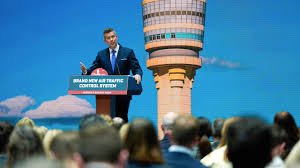New Jersey has always played a critical role in the country’s transportation and aviation sectors. With one of the busiest air corridors in the world passing right over our heads, and major international hubs like Newark Liberty International Airport (EWR) facilitating travel and commerce across the globe, it’s no surprise that our air traffic control (ATC) systems are constantly under pressure.
But today, that pressure has reached a breaking point.
A Crisis Brewing in Newark’s Skies
Newark’s air traffic control system is in a state of crisis, and there’s no quick fix in sight. Staffing shortages and outdated technology are creating delays, safety concerns, and increasing the workload for those already working one of the most high-stress jobs in the country. Air traffic controllers at Newark are expected to manage the complex ballet of planes coming in and out of one of the nation’s most tightly packed airspaces. Yet, many are doing so with decades-old equipment and without the support of a full team.
The current situation isn’t just inconvenient—it’s unsustainable.
Behind the Radar: What’s Really Going On?
At the heart of the issue is a long-standing neglect of infrastructure and human capital. The FAA has acknowledged the need for more trained personnel and better tools, but the hiring process for air traffic controllers is rigorous, time-consuming, and not nearly fast enough to meet current demands. Moreover, the technology many controllers rely on is aging, prone to glitches, and not up to the task of managing today’s sky-high volume of flights.
Add to that a demanding schedule, high stakes, and a critical shortage of qualified applicants, and it’s clear why the system is teetering on the edge.
New Jerseyans know the feeling all too well—missed flights, delayed arrivals, and longer-than-usual wait times on the tarmac. It’s more than just a nuisance; it affects business travel, tourism, family reunions, and the economic flow through the entire region.
Why This Matters for New Jersey’s Future
Newark Liberty isn’t just a transportation hub—it’s a major economic engine for New Jersey and the greater tri-state area. A fully functioning and modernized air traffic control system directly impacts the efficiency of cargo shipments, business travel, and international commerce.
To keep up with the state’s broader economic and technological ambitions, as detailed in our Technology & Business section, New Jersey must prioritize strategic investment in aviation infrastructure. That includes accelerating modernization plans, improving recruitment and training pathways for ATC personnel, and investing in next-gen systems that can reduce controller workload and improve safety margins.
The Human Toll of a Broken System
The air traffic controllers who keep our skies safe are real people doing incredibly difficult work under immense pressure. Many have reported burnout, mental exhaustion, and even consider leaving the profession altogether. With such high stakes, it’s crucial that we take action—not just for the safety of our flights, but for the well-being of those guiding them.
Support must go beyond technology. It must include mental health services, better working conditions, and a culture that values the people who are responsible for hundreds of lives every single hour.
What’s Next?
As state and federal leaders debate funding and policies, it’s up to citizens and community leaders to advocate for swift, meaningful action. Newark’s air traffic control crisis is a symptom of a larger issue—an aging transportation infrastructure not designed to handle today’s demands.
To move forward, New Jersey must embrace a proactive, long-term strategy that blends innovation with compassion and strategic workforce development. Whether through public-private partnerships, federal grants, or direct state investment, we need bold action to solve this very real, very pressing problem.
New Jersey deserves an air travel system that is as dynamic, safe, and forward-thinking as its people. Until then, expect turbulence—not just in the skies, but in our economy and daily lives.
Explore more updates on the intersection of infrastructure, innovation, and economic development in our Technology & Business coverage.











